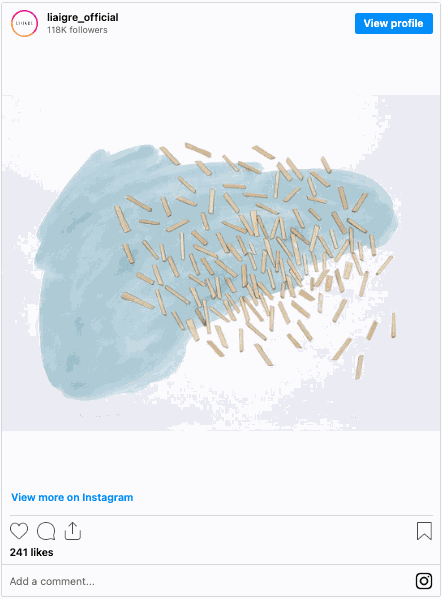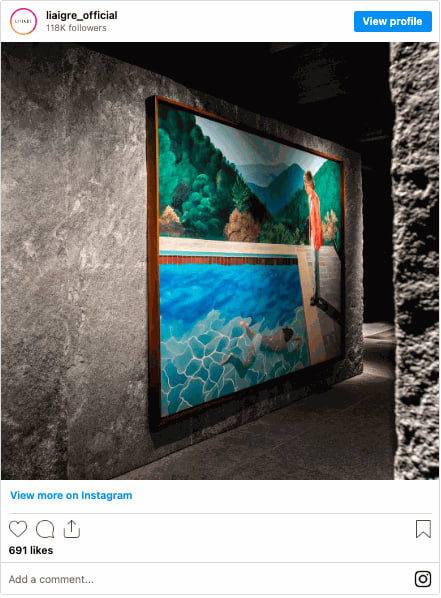How to refine one’s taste in art for a cohesive collection may be another concern for new collectors. With countless ways to discover, appreciate, and learn about art, it can be difficult to choose the way forward—especially as art is highly subjective, emotional, and by no means an exact science.
While reading and visiting exhibitions and museums can help with exposure to art styles and movements, as Sicilia shares, it’s important to embrace the journey, and the continuous learning involved. As a collection inevitably reflects one’s personality, history, culture, and sensitivity, he advises new collectors to first and foremost “purchase art they feel like living with”.

ABOVE Art can be used to introduce a playful pop of colour in muted interiors (Photo: Sylvie Becquet, courtesy of Liaigre)
This doesn’t just mean curating your art pieces based on the aesthetic of your home. “While it’s crucial to consider how artworks complement your living space, the primary focus should always be on selecting pieces that resonate with you,” Chong explains. “Some may find fulfilment in a diverse collection that spans various styles and themes, while others may prefer a cohesive aesthetic throughout their collection. There’s no right or wrong approach; the key is to curate a collection that brings you joy and speaks to your soul.”
Unlike what new collectors may think, a comprehensive knowledge of art history is not a requirement to start collecting. “It’s often misunderstood that extensive knowledge or experience in the art world is a prerequisite for collecting. I think being a collector requires an open mind and a willingness to explore,” shares Chong. “Discovering your passion for art is the first step; from there, your taste will naturally evolve as you engage with different works.”

ABOVE Tadashi Kawamata’s solo art show (Photo: Sylvie Becquet, courtesy of Liaigre)
Having a mentor to guide you on your journey can be a blessing, but, as Cuturi points out, not everyone has that luxury. He adds. “In my case, I slowly learned (and I am still learning) by purchasing the art I enjoyed. With time, I realised that my eye for art and my priorities were gradually shifting.”
While Chong does recommend trusting your instincts and allowing yourself to be drawn to pieces that resonate with you, closing yourself off to a specific genre of art will do your evolution as a collector a disservice. She recommends being open to a wide variety of work, across different styles, mediums, and cultures.
She agrees with Sicilia that visiting art galleries, fairs, and museums regularly is a great way to gain exposure to the art world and its history, and adds researching artists, art movements, and historical contexts behind artworks as another way to gain a deeper understanding.

ABOVE Tadashi Kawamata's solo art show (Photo: Sylvie Becquet, courtesy of Liaigre)
The benefit of networking cannot be understated either: “Engage with the art community, attend art events, and participate in discussions. All of these will broaden your perspective and expose you to new ideas,” she suggests.
Beyond evolving and refining your taste in art, another skill that comes with time and is often overlooked is a sixth sense for pricing. “The price of an artwork is influenced by several factors. Artist recognition and reputation play a significant role, with established artists commanding higher prices. Additionally, the cost of materials, especially for sculptures and larger pieces, and the condition of the artwork, also contribute to the value,” Chong explains.
“When determining whether an artwork is worth its price for my personal collection, I acknowledge the objective elements such as the artist’s reputation and material quality, but I ultimately trust my gut instinct.”
What makes a good art collection?

What, then, makes a good collection? While a personal, private collection doesn’t need to impress anyone but you, Sicilia maintains that a collection showcased to the public or even your inner circle can certainly be curated with a specific direction in mind and an appreciation for coherent choices.
Chong concurs: “A good art collection is more than just a random assortment of artworks; it’s a cohesive and thoughtfully curated selection that reflects the collector’s taste, interests, and values.”
Some key elements that contribute to a successful art collection, according to Chong, include “vision and focus”, as well as a balance of diversity and similarity.

ABOVE David Nash's solo art show (Photo: Sylvie Becquet, courtesy of Liaigre)
“Variations in mediums, art styles, cultural influences, and historical periods should be balanced out by a clear theme that provides a sense of direction and allows for the expansion of the collection in a focused manner,” she explains.
One special secret she shares with us? “Collectors can distinguish themselves by championing emerging artists who produce original and distinctive works—this brings a unique flair to the collection.”
Collecting art in Singapore and around the world
As Cuturi points out, supporting the art scene in your own country or region allows you to “develop a more intimate way of collecting”, as it facilitates the acquisition of an artist’s full collection over a longer period, developing a strong connection with the artist.
In Singapore specifically, collecting local art offers “a unique experience enriched by the country’s diverse cultural tapestry”, says Chong. “With a blend of influences in its history, collectors can encounter a rich array of local, regional, and international artworks that reflect this multifaceted heritage.”

Sicilia sees much value in looking outwards and sourcing your art from other regions as well, reminding us that “each country has its own identity and culture; contemporary art is a way to discover other modes of thinking”.
Collecting art while travelling, or even travelling for the sole purpose of visiting galleries and adding to one’s collection, can be another purposeful way of curating. “Travelling to collect international art is a profoundly enriching experience,” Chong shares. “It fosters connections with people from diverse backgrounds and creates a sense of community among fellow art enthusiasts worldwide. Despite language and cultural differences, a shared passion for art serves as a universal language that transcends barriers.”

ABOVE Pic Poc Lampadaire by Hubert Le Gall (Photo: Cuturi Gallery)
Exploring various genres and encountering emerging talents on a global scale is one of the most rewarding aspects of collecting for Chong, who enjoys immersing herself in different artistic traditions and “learning from the perspectives of artists from around the world”.
However, she does warn collectors of the complications involved: “Collecting art from different countries comes with some challenges, such as navigating logistical issues, understanding local art markets, and ensuring authenticity when acquiring pieces.” She maintains that these challenges are often outweighed by the positives.
Storing and displaying an art collection
Once collectors have accumulated a large number of art pieces, various options come into play beyond displaying it all at home: selling a few artworks, donating them, gifting them to loved ones, storing them for future use, or even exhibiting them in a gallery. Cuturi considers all of these options perfectly valid and believes the choice is very personal.
Chong agrees but believes that, ideally, “good art should be shared with others. I recommend exhibiting the artwork in a public space, or donating it to a gallery or a museum, where it can be appreciated by a wider audience”.
Selling or storing art can translate into a decent investment, but Chong hopes that an art collection can serve more than a monetary purpose.

ABOVE A close-up look at the art used around the yacht, courtesy of Liaigre (Photo: Mark Seelen)
She states: “While there is undoubtedly an aspect of investment involved in collecting art as a gallerist, particularly when supporting emerging artists, I believe the true essence of art transcends mere financial gain. Art should be valued for its ability to evoke emotions, spark conversations, and enrich lives, rather than solely as a commodity for financial growth. Collecting artwork solely for its potential appreciation in value undermines the intrinsic value and purpose of art.”
If one does opt for storage, this comes with some important considerations. Sicilia points out: “For the preservation of artworks, it is important to be mindful of humidity and direct sunlight exposure.”
For those new to storing art, Cuturi recommends engaging “a professional art handler for proper packing, who can provide temperature-controlled storage”.
Chong adds: “Consider storing artworks in a dark or low-light environment or use UV-filtering glass or acrylic to protect against harmful UV rays. Contrary to misconception, not all artworks require extensive maintenance. I’m always glad to recommend pieces that are low-maintenance for clients concerned about artwork upkeep.”
Learning about art and finding your community

ABOVE Contemporary interiors ornamented with striking art, courtesy of Liaigre (Photo: Sylvie Becquet)
For many collectors, meeting fellow art enthusiasts and engaging with the community are some of the most enjoyable aspects of the art world. For new and aspiring collectors, it can seem challenging to get involved, but it really comes down to showing up and talking to the people who are already doing the work. As Sicilia points out, art fairs can be a particularly fruitful meeting space, bringing enthusiasts together from different corners of the world and all walks of life.
It doesn’t need to be an intimidating experience. While Chong admits that “there is a stereotype that people in the art world are elitist”, she’s always had positive interactions with fellow art lovers and considers galleries and auctions some of the best places to meet other collectors.
“There is a strong sense of community between art collectors, as we all have a sincere passion for art that we want to share with others.”
Getting involved with the art community can also be a fantastic way to learn more about the world of collecting and everything that comes with it. “I am a firm believer that people are the best resources. Talk to people who are well-versed in the world of art, chat with collectors about their experiences, and be open to advice,” Chong suggests. “I’ve found that most individuals are eager to share their expertise and passion, making personal interactions a rich source of learning and growth in the realm of art and collecting.”









